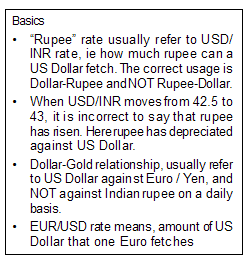The relationship looks quite simple which every investor in Gold seems to have mastered, more so as the tremendous interest generated in online trading in Commodity Futures over these years, has put a lot of related information in the public domain. Which is why, an enthusiastic investor in Gold or its futures call up his Bank or his Brokerage to see how Dollar is doing, every time Gold makes a bold move either up or down.
Period
What kind of information is this investor trying to find out?
• Is he talking about the commodity currencies like Australian Dollar, New Zealand Dollar, or the Canadian Dollar? (The Canadian currency has the highest correlation with Crude amongst the world currencies). It is highly likely that a normal investor is oblivious of the importance of these currencies, and it is fair to assume that his reference is usually to the US Dollar.
• Having assumed that his reference is to the US Dollar, what is the relationship he is trying to understand? Is it against the Indian Rupee? Or is it against competing global currencies like Euro, or Yen? Let us have a look at the Indian Rupee first.

Indian Rupee: In India, the currency regime in place with respect to the US Dollar is a “managed float”. This means that even though, officially, the Indian Rupee’s value is allowed to be market determined, RBI intervenes with a view to curb excess volatility. What this means to us is that, largely, India rupee moves in tandem with global cues, but occasionally makes a big move, to which the RBI responds or acts is proactive (eg: by easing overseas borrowing rules and increasing the limits on foreign investment in domestic bonds; measures taken on 30May2008). As the rupee moves normally goes without causing major sudden impact on Commodity prices, these occasional big moves shakes up the price views in commodity futures prices, whose moves are generally very much in tandem with global commodity futures prices. In this context it is important to see how the currency moves affect commodity prices in India, be it futures or spot. A large portion of the India’s Dollar payment is mainly for payment for Oil which is mostly Dollar denominated. This means that with every big leap in Crude prices, there is Dollar buying from Oil companies/Govt. to cover import liabilities, and causing Indian Rupee to depreciate and vice versa.
Impact of Currency movement on Commodities:
Broadly speaking, a weak local currency supports local commodities with robust domestic market and export demand.
Gold
As against most Indian traders’ concept, Dollar’s moves in the context of Gold normally refer to the strength/weakness against Euro and not against Indian Rupee, as the currency markets respond more to the release of US or Eurozone Economic events. However, it is also incorrect to say that moves in INR distorts Indian gold future prices, as such currency moves are fundamental to determining Gold’s value, due to its role as an alternate currency, Moreover, Indian rupee is also crucial in Gold price moves, as India is the largest consumer in volume terms, accounting for 22% of demand. (Source: World Gold Council, 2006 figures).
Crude Oil, and Base metals like Copper, Zinc, etc.
As these commodities are all dollar denominated, weakness in dollar gifts buying power to holders of other currencies, lifting prices of these counters. However, as Base metals also act as a barometer of economy (construction/manufacturing/automobile sectors), at times, a weakness in Dollar may actually depress prices, if the traders feel that the weakness in Dollar at such point is in fact caused by deterioration of economy. Amidst these events, moves in Dollar-Rupee makes the situation more complex, as a weak Rupee accelerates an uptrend, and vice versa. Similarly strengthening in Rupee accelerates a fall, and
Spices: Depreciating Rupee attracts exporters and broadly lifts prices of spices and other commodities, which has good export demand.
Rubber: Being a yen based commodity in Japan, Dollar-Yen’s moves are closely followed by Rubber traders. Yen’s appreciation normally pulls TOCOM prices down, and these signals are taken up by Indian players. But as India has a robust spot market and with prices being rupee denominated, it is less of a price taker, more so as Indian Markets are exposed to international events on a live basis for a greater extent of time, much more than the Japanese or Chinese Rubber markets.
Closing Thoughts: Value of a Commodity is no longer purely a function of supply and demand. As globalisation has given wider access to world markets, an understanding of inter currency relationships, and moves by local as well as World’s Central Banks is essential for a better perspective of your commodity’s price.